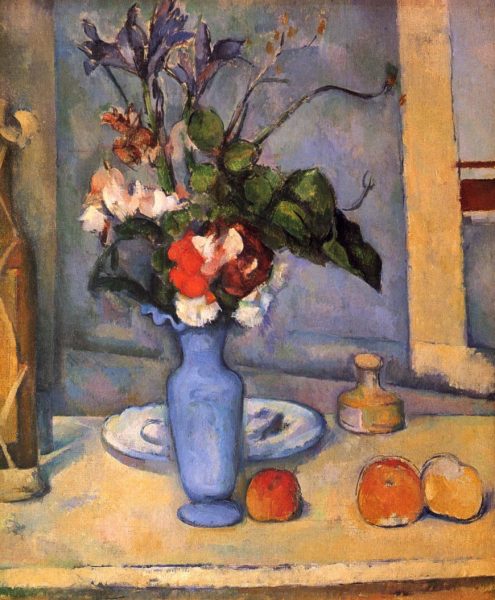
_____________________________________________________________________________________
Formalism I: Formal Harmony
by Dr. Charles Cramer and Dr. Kim Grant
This work is licensed under a Creative Commons Attribution-NonCommercial-ShareAlike 4.0 International License. (See citation below.)
When James McNeill Whistler first exhibited his painting Nocturne in Black and Gold in 1877, the prominent Victorian art critic John Ruskin accused him of “flinging a pot of paint in the public’s face.” Whistler sued Ruskin for libel, and over the course of the trial and beyond he articulated a defense of his work that is a famous example of a very influential modern theory of art called formalism.
Art as formal beauty
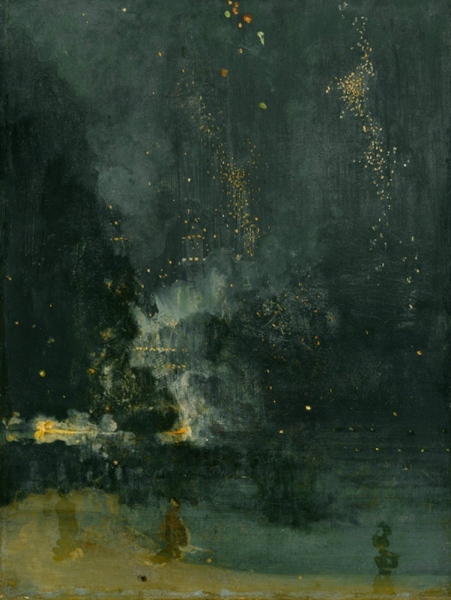
James McNeill Whistler, Nocturne in Black and Gold, the Falling Rocket, 1875, oil on panel, 60.2 x 46.7 cm (Detroit Institute of Arts)
Whistler’s defense was that art is about beauty. Not the beauty of certain kinds of things — a swan, an idealized nude, or a picturesque landscape — but the beauty of certain color combinations in certain patterns: formal beauty. Denying that his Nocturne was an attempt to show an accurate view of a place, Whistler called it an “artistic arrangement,” and said that his “whole scheme was only to bring about a certain harmony of color.” [1] What we are intended to appreciate, then, is not the painting’s likeness to a scene in nature (which happens to be a firework display over a river), but instead the asymmetric balance of the composition, the calligraphic quality of the painterly marks, and the way the orange flecks sparkle against the dark blue-greens.
Whistler frequently gave his paintings titles typical of musical compositions, such as symphony, harmony, arrangement, or nocturne, and listed their dominant color combinations as though they were the equivalent of a musical key. This analogy with music helps to divert our attention away from the subject matter of the painting to its form. When we hear a piece of instrumental music we do not expect it to imitate sounds from the real world. Instead, we just appreciate the way the sounds create pleasing harmonies. Why should visual art not be appreciated in the same way?
Art for art’s sake
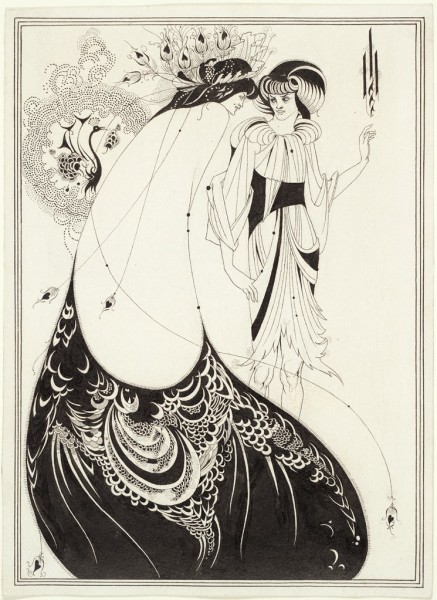
Aubrey Beardsley, The Peacock Skirt, plate 2 of ten illustrations for Oscar Wilde’s Salomé, 1893, black ink and graphite on white wove paper, 23 x 16.8 cm (Harvard Art Museums)
This theory of art was promoted by a late-nineteenth century literary and artistic movement called “Aestheticism,” which included Walter Pater, Oscar Wilde, and Aubrey Beardsley, as well as Whistler. Their motto, “art for art’s sake,” implicitly rejected the non-aesthetic goals commonly assigned to art, such as imitation of nature, moral instruction, spiritual exaltation, and emotional expression.
This idea of art was not entirely novel to the nineteenth century. The ancient Greeks had theorized that aesthetic harmony in both music and visual art resided in certain mathematical proportions. What is new here is the prominence that the Aesthetes granted this idea. For them, formal beauty was not just one of many potential goals for art; it was the pre-eminent and perhaps only quality the artist should strive for.

James McNeill Whistler, Note in Red: The Siesta, 1883-84, oil on panel, 21.6 x 30.5 cm (private collection)
It was particularly shocking to Ruskin and Victorian England that the Aesthetes denied art’s role in improving public morality. Whistler scorned people who look “not at a picture, but through it,” to consider whether it will “better their mental or moral state.” [2] He believed that art is not a vehicle for public reform any more than it is a means to reproduce the appearances of nature. We shouldn’t keep looking outside the painting for its purpose, but rather enjoy it for what it in fact is: a surface covered with harmonious arrangements of color.
Theories of art that concentrate on the sensory or material qualities of the work itself are called “formalist.” Note that formalism is not a historical style or movement like Impressionism or Cubism. Rather, it should be considered a basic theory that tries to explain what art is or should be.
Formalism and modern art
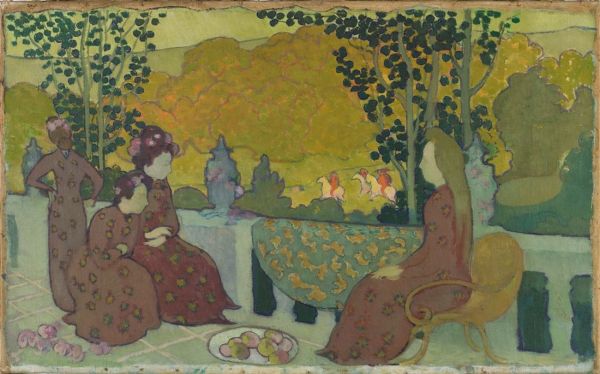
September Evening, 1891.
A number of modern movements emphasized the purely aesthetic qualities of art. In 1890 the Symbolist artist Maurice Denis famously asserted, “A painting — before being a battle horse, a nude woman, or some anecdote — is essentially a flat surface covered with colors arranged in a certain order.” [3] Correspondingly, Denis’s paintings read as surface patterns as much as (or even more than) representations of real-world spaces and objects.
In another famous statement, the Fauve artist Henri Matisse confessed in his Notes of a Painter (1909), “my ambition is limited, and does not go beyond the purely visual satisfaction such as can be obtained from looking at a picture.” [4]
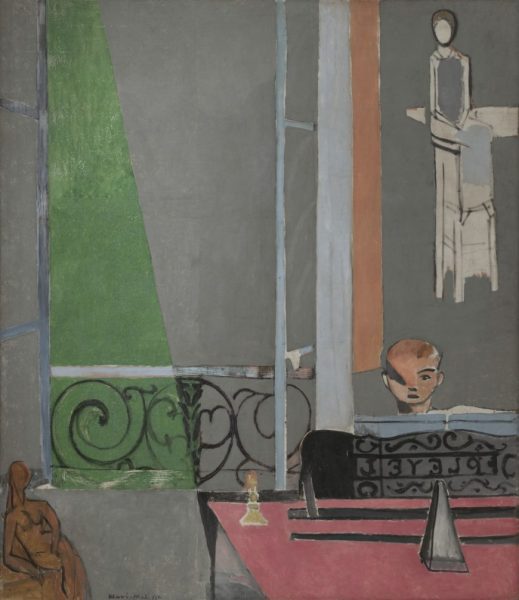
Henri Matisse, The Piano Lesson, 1916, oil on canvas, 245.1 x 212.7 cm (MoMA)
Like Whistler, Matisse sought harmony in his works. He conveyed aesthetic pleasure not only through his choice of sensual and tranquil subjects — lounging nudes, picnics, dances, quiet domestic interiors — but also through form. In The Piano Lesson the painting’s nominal subject of a boy practicing the piano is just a pretext for showcasing a complex pattern of vivid colors against cool gray, and for contrasting rectilinear shapes with the swirling black tracery of the balcony railing and music stand.
Clive Bell and “Significant Form”
For many modern artists (including Matisse and Denis), a concern with formal harmony was paired with other goals, such as emotional expression, spirituality, and social agency. Formalist art theory was therefore mostly developed by art critics, rather than by artists themselves.

Left: Bowl with horsemen, late 12th – early 13th century, central Iran, Seljuk period (Cincinnati Art Museum, photo: Wmpearl, CC0); Right: Piero della Francesca, Flagellation of Christ, 1468-70, oil and tempera on panel, 58.4 x 81.5 cm (Galleria Nazionale delle Marche, Urbino)
The English art critic Clive Bell articulated a formalist theory of art in his 1914 book Art. He claimed that the purpose of art is to evoke a particular kind of feeling that he called “aesthetic emotion.” This feeling is not caused by the subject, but by the form of the artwork:
What quality is shared by all objects that provoke our aesthetic emotions? What quality is common to Sta. Sophia and the windows at Chartres, Mexican sculpture, a Persian bowl, Chinese carpets, Giotto’s frescoes at Padua, and the masterpieces of Poussin, Piero della Francesca, and Cézanne? Only one answer seems possible — significant form. In each, lines and colours combined in a particular way, certain forms and relations of forms, stir our aesthetic emotions. Clive Bell, Art, (New York: Frederick A. Stokes, 1913), p. 8.
Note that Bell’s examples include architecture and craft as well as paintings and sculptures: any made object can be art if it exhibits significant form.

By the same token, not all paintings and sculptures qualify as art, according to Bell. In a painting such as William Powell Frith’s The Railway Station, the goal is accurate depiction. Certain anecdotes depicted in the work may arouse emotions, such as the mother embracing her child, but these are everyday emotions, not aesthetic emotions. The detail of the work may excite our admiration of the artist’s skill, but for Bell that skill was misdirected: true artists are dedicated to evoking aesthetic emotion through significant form.

Paul Cézanne, The Blue Vase, 1889-90, oil on canvas, 61 x 50 cm (Musée d’Orsay)
Bell admired works by non-Western and pre-Renaissance artists, whose lack of concern with representational accuracy freed them to use line, shape, and color to create significant form. In Bell’s view, certain recent artists such as Paul Cézanne had rediscovered art’s true purpose as evoking aesthetic emotions, rather than merely copying the appearances of nature.
The autonomy of art
One of the hallmarks of formalist art theory is the idea that the work of art should be experienced in itself, and not in relation to anything else. We should not compare the work with nature to judge how true-to-life it is. It makes no difference whether the work is a portrait of a king or pure abstraction, and we need not inquire about the social context in which the work of art was produced, whether it was second-century Rome, eighteenth-century Japan, or twenty-first century America. Everything we need to know about a painting is contained within the four edges of its frame. As Bell put it:
To appreciate a work of art, we need bring nothing from life, no knowledge of its ideas and affairs, no familiarity with its emotions. Art transports us from the world of man’s activity to a world of aesthetic exaltation … Clive Bell, Art, (New York: Frederick A. Stokes, 1913), p. 25.
For its proponents, the formalist theory of art has the benefit of elevating art and the artist above everyday utilitarian and social concerns. For its opponents, however, art is and has always been part of life, and abstracting it from life’s concerns impoverishes its richness and diminishes its important social roles.
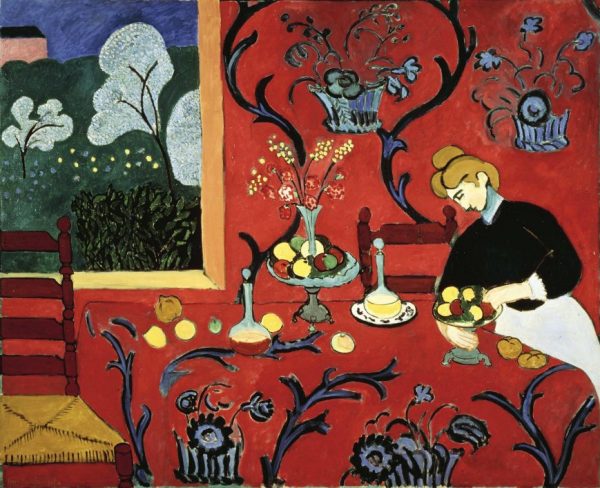
Henri Matisse, The Dessert (Harmony in Red), 1908, oil on canvas, 180.5 x 221 cm (The State Hermitage Museum)
Thus, while it is certainly possible to analyze and appreciate this Matisse painting solely in terms of its formal qualities, to do so would require overlooking significant questions about gender roles, social class, consumption, and domesticity that are also raised by the work. In recent decades, these broader social concerns have dominated the approaches of most artists, critics, and historians, and purely aesthetic concerns have become less important.
There is another type of formalist art theory that arose slightly later and became dominant in the mid-twentieth century: one that asks viewers to focus not on formal harmony or a special “aesthetic emotion,” but instead on the properties of the materials or medium of which the work of art is made. We shall examine this aspect of formalism in Formalism II: Truth to Materials.
Notes:
- “The Action,” in James Abbot McNeill Whistler, The Gentle Art of Making Enemies (1892; reprint New York: Dover Publications, 1967), pp. 3, 8.
- “Mr Whistler’s ‘Ten O’Clock’” (1885), in The Gentle Art of Making Enemies, p. 138.
- Maurice Denis, “Definition of neo-traditionism” (1890), in Jean-Paul Bouillon, ed., Le ciel et l’arcadie (Paris: Hermann, 1993), p. 5 (authors’ translation).
- Matisse, “Notes of a Painter,” sixth paragraph.
Citation: Dr. Charles Cramer and Dr. Kim Grant, “Formalism I: Formal Harmony,” in Smarthistory, April 3, 2020, accessed July 29, 2020, https://smarthistory.org/formalism-i-formal-harmony/.
